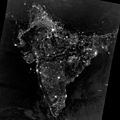English: On 12 November 2012, the
Visible Infrared Imaging Radiometer Suite (VIIRS) on the
Suomi NPP satellite recorded this view of the Indian subcontinent at night during the festival of
Diwali. The picture is based on data collected by the VIIRS "day-night band," which detects light in a range of wavelengths from green to near-infrared. The picture has been brightened to make the city lights easier to distinguish.
Each autumn, Hindus around the world light lamps, candles, and firecrackers as part of a five-day festival known as Diwali. The celebration, which has roots as a harvest festival, usually falls between mid-October and mid-November. In 2012, it began on 11 November.
Most of the bright areas in the picture are cities and towns in India, the country with the world's largest Hindu population. India is home to more than 1.2 billion people and has 30 cities with populations over 1 million. (For comparison, China has 62 cities with more than 1 million residents and the United States has 9). Cities in Bangladesh, Nepal, and Pakistan are also visible near the edges of the picture.
A picture that claims to show the region lit for Diwali has been circulating on social media websites and the Internet in recent years. In fact, it does not show what is claimed. That picture, based on data from the Operational Linescan System flown on U.S. Defense Meteorological Satellite Program (DMSP) satellites, is a colour-composite created in 2003 by NOAA scientist Chris Elvidge to highlight population growth over time. In that picture, white areas show city lights that were visible prior to 1992, while blue, green, and red shades indicate city lights that became visible in 1992, 1998, and 2003 respectively.
In reality, any extra light produced during Diwali is so subtle that it is likely imperceptible when observed from space.




